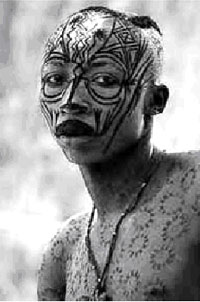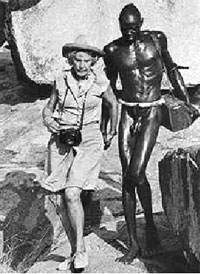Taschen, the German publishers, have published a large and expensive limited edition book (2,500 copies) of the African photographs of Leni Riefenstahl. Each copy is signed by the controversial and legendary film-maker. The publication is bound in blue synthetic leather, costs ˙850, and is a weighty investment but one that will pay rich dividends to anyone interested in Reifenstahl's work, the tribespeople of the Sudan or the art of photography itself. It is a fantastic collection and a fitting celebration indeed for this formidable artist's 100th birthday.

Riefenstahl began her career as a dancer, touring Germany and Europe as a soloist before a knee injury forced her to retire. Undeterred, she soon transformed herself into a film star, appearing in several German adventure films set in mountain landscapes in the late 1920s and early '30s, movies that set off perfectly her beauty and athleticism¨attributes she was later to focus on in her own work. It was through her work as an actress that she learnt the techniques of film-making and photography, a grounding that enabled her to make the transition into directing¨a remarkable achievement itself in the male-dominated world of cinema. Her first film, The Blue Light was well received but soon led her into troubled waters. It caught the attention of a rising young political star, Adolf Hitler, who invited her to film the 1934 Nuremberg rally. Although she spurned his amorous attentions, Riefenstahl did fall victim to Hitler's legendary charisma, later telling BBC News, "I am one of millions who thought Hitler had all the answers. We saw only the good things, we didn't know bad things were to come." Her film of the Nuremberg rally, Triumph of the Will, was an astonishing piece of documentary film-making as well as a brutally effective propaganda tool for the Third Reich. Two years later, again at Hitler's bidding, she made the visually stunning Olympia, a sports documentary of the 1936 Berlin Olympics. It was a massive undertaking, involving 40 cameramen, 250 miles of film and 18 months of editing, not to mention many innovative filming techniques¨techniques now taken for granted in sports photography and film.

Because of her involvement with Hitler, after the war Riefenstahl's film career came to an abrupt end. Reviled as a Nazi sympathiser (she was taken into police custody several times between 1945-47), it was inevitably difficult for her to escape pariah-status in Germany and the rest of Europe. While she was bound up with innumerable court cases, her career drifted until in 1956 she set out to make a film about the illegal slave trade in Africa. This first expedition was an inauspicious introduction to a continent she soon came to love, as just north of Nairobi, her jeep overturned hurling her through the windscreen. She was not expected to live. But resilience and determination saw her through and glimpses of Masai warriors carrying spears and wearing tribal costume sparked a lasting fascination with Africa. In her interview with Kevin Brownlow, she describes how the mixture of the strange and the familiar was so seductive: "I read Hemingway's book The Green Hills of Africa. And that influenced me. And when I got there, this shimmer, this light that I found in Africa, the warmth and the colours that look so completely different in the heat from those of Europe, all that fascinated me greatly. It reminded me of the Impressionist painters¨Manet, Monet, Cezanne."

However, it was a single picture of a Nuba wrestler¨one tribesman carried on the shoulders of another¨taken by the English photographer George Rodgers, which clinched her interest. She thought it looked like a Rodin statue, so beautiful and enticing that she could not help but want to find and see and film these people herself. She determined to seek out the Nuba tribe in a remote corner of the Sudan and in 1962 she got her chance. Riefenstahl was given the opportunity to make a scientific film for the German Nansen society and so set off promptly for Kordofan. After a long journey she eventually spotted the distinctive round houses of the Nuba. She describes her excitement at this first sighting of the Nuba in her memoirs, "The blacks were led by a number of men covered in snow white ashes, who were naked and wore strange head dresses. They were followed by others whose bodies were painted and adorned with white ornamentation. At the end of the procession were women and girls, likewise painted and decorated with white pearls. They walked straight as candles and carried kalabashes and large baskets on their heads. There was no doubt about it; these could only be the Nuba we were searching for." Riefenstahl had come to Africa to make a film, but the Nansen project collapsed and she was forced to fall back on her trusty Leica camera. It was only as the result of one failed project that a great stills photography career began.
This collection includes photographs of the Mesakin Quissayr, the Masai, Shilluk, the Dinka, Murle, Nuer and Latuka. Tribal life is captured here, from working the fields to baking bread, from intimate portraits of family life to great gathered crowds of warriors, from the carefree informality of children playing in the dust to a series of images showing the extraordinary, painstaking artistry of the Kau (part of the Nuba tribe) in face and body painting. These beautiful, elaborate face 'masks' are designed to accentuate the wearer's best features and no pattern or motif is ever repeated¨the Kau's decorative imagination seems inexhaustible. In these and other pictures, the sheer size of the pages in this book is a blessing¨in the portraits, extreme close up shots reveal not just the markings and facial expression, but the very texture of the painted skin, while double-page vistas allow a real sense of the endlessly yellow, endlessly dusty savannah stretching out beneath an equally unrelenting blue sky. Above all though, it is Riefenstahl's eye for and delight in physical beauty which shines through. Turning the pages reveals acres of lovingly shot skin¨painted, oiled, ash-dusted, pierced¨there is an unmistakable and unashamed sensuality to all this flesh. There is little doubt in my mind that Reifenstahl's interest in the body beautiful denotes a lingering fascist ideal despite the fact that her depictions of the black tribesmen's beauty is entirely at odds with Hitler's pathological race theories. Brownlow, on the other hand, clearly enthralled by Reifenstahl's genius, stays out of the political debate and lets the photographs speak for themselves (with the aid of an illuminating index and a comprehensive biography, which, like his introduction, are also translated into French, German and Japanese).
Beyond its sheer photographic achievement, this collection is also a record of a vanished world. When Riefenstahl first visited the Nuba it was an offence for her to photograph them in their habitually naked state. A government policeman went with her and she had to send her pictures to Khartoum to be censored. Yet Riefenstahl clearly sees the Nuba's nakedness as an important part of the innocence and honesty she revered in them. This was a gentle, peace-loving tribe who had respect for women (unlike the Masai, for whom women had less value than cattle). She tells Brownlow that, "the time I spent with the Nuba was among the happiest of my life, among the most beautiful of my life. It was just wonderful. Because they were always cheerful, laughing all day long, good people who never stole a thing. They were very happy with everything, pleased with everything." In retrospect, the happiness of this first experience of the Nuba was to take on a pre-lapsarian quality, for five years later, when Riefenstahl returned, the tribe was much altered. No longer permitted their nakedness by the Sudanese government, the Nuba were dressed in rags, and as in Eden, with clothing came a hitherto unknown sense of shame. Now the wrestlers whom just a few years previously she could have captured in all their naked glory were too embarrassed to remove their trousers. It seemed too that a series of bad harvests had forced young men to seek a living in the towns and with the coming of money, the easy equality of the tribespeople was disrupted. She wrote in her memoirs that, "Human happiness simply dissolves the moment it comes in contact with the darker sides of humanity." Fearing that the same fate would befall the Nuba as had overcome the Australian Aborigines, on her next trip to Africa Riefenstahl sought out a more distant, more untouched Nuba tribe. This was the tribe of the great mask painters, the Kau, who had never been photographed before. More difficult to work with than the friendly Mesakin Nuba, the Kau nonetheless inspired some of her most fascinating photographs. Even the Kau, however, were ultimately touched by what Riefenstahl saw as the disfiguring hand of tourism and the cash it held out.
As Kevin Brownlow concludes in his interview, "Leni Riefenstahl had travelled from theTwentieth Century to the Stone Age. She had seen people living in perfect harmony with nature and she had seen what the 'plague of civilisation' had done to them. One great benefit of civilisation, however, is the photograph, that frozen moment of time. To receive such a record of Leni Riefenstahl's journeys is a priceless gift on the occasion of her centenary." We are lucky to be able to share this gift through such a splendid and unique photographic collection. ˛